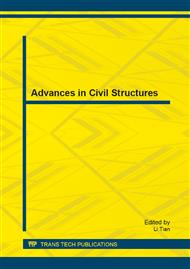p.1576
p.1581
p.1585
p.1590
p.1596
p.1601
p.1605
p.1610
p.1616
Erosion-Resisting Characteristics of Concrete under Freeze-Thaw Action
Abstract:
Erosion-resisting characteristics of C25C35 and C50 concrete are tested in an environment of freezing and thawing cycle. The result shows that the corrosion becomes more and more serious under clear water, the liquor of sodium sulfate, the liquor of sodium sulfate and sodium chloride after 300 freeze-thaw cycles. This kind of phenomenon also happens when the water cement ratio becomes increasingly bigger. The concrete samples which are protected by SPUA (Spray Polyurea Elastomer) are in good condition. The main problem is spalling from surface to interior, which shows different tendency in different salting liquid.
Info:
Periodical:
Pages:
1596-1600
Citation:
Online since:
August 2013
Authors:
Keywords:
Price:
Сopyright:
© 2013 Trans Tech Publications Ltd. All Rights Reserved
Share:
Citation:


